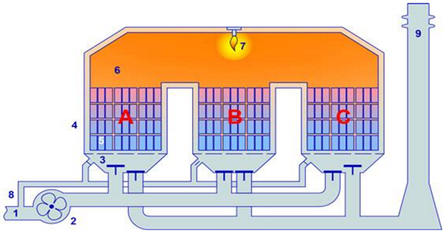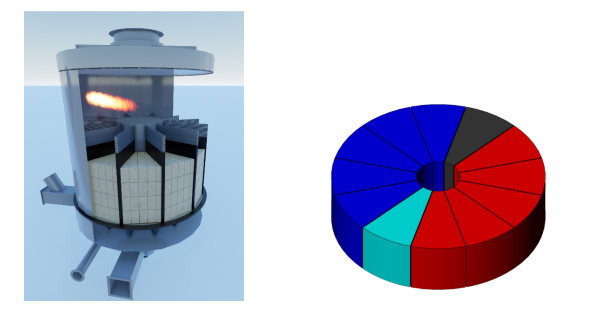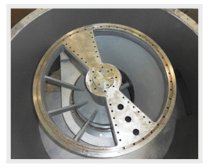Principle of RTO
RTO is to heat the organic waste gas to more than 760 ℃, so that the VOCs in the waste gas can be oxidized and decomposed into carbon dioxide and water. The high-temperature gas produced by oxidation flows through the special ceramic heat storage body to heat the ceramic body and "store heat". This "heat storage" is used to preheat the subsequent organic waste gas, so as to save the fuel consumption of waste gas heating. The ceramic regenerator shall be divided into more than three (including three) zones or chambers, and each regenerator shall go through the procedures of heat storage, heat release and cleaning in turn, and work continuously again and again. After the "heat release" of the regenerator, some treated and qualified clean exhaust should be introduced immediately to clean the regenerator (to ensure that the VOC removal rate is more than 99%), and the "heat storage" procedure can be entered only after the cleaning is completed. RTO regenerative waste gas treatment equipment is characterized by low operation cost, high treatment efficiency of organic waste gas, adaptability to waste gas concentration of 1000~10000mg/m3, and decomposition efficiency of 99%--99.5%. It is currently the most economical and reliable VOCs treatment technology that meets the strict emission standard of 50mg/m3, and has been widely used.
RTO organic waste gas treatment equipment can be divided into valve switching type and rotary type.
Valve switching RTO is the most common RTO organic waste gas treatment equipment, including the typical first-generation technology 2-Beds RTO and the second-generation technology 3-Beds RTO. The regenerator is filled with two or more ceramics, and the direction of air flow is changed through the switching of valves, so as to achieve the purpose of preheating VOC waste gas. Generally speaking, the more regenerators there are, the higher the purification efficiency and thermal efficiency are. 5-room RTO and 12 room RTO are commonly used. 5-room RTO has high cost and is rarely used. 12 room RTO is transformed into a cylindrical rotary type and has become a product of the third generation technology.
ification rate can only reach 90%, which cannot meet the current environmental emission requirements of 50mg/m3.
RTO treatment of organic waste gas has the following advantages:
(1)It can treat almost all kinds of organic waste gas.
(2)The flow of treated organic waste gas is very elastic (nominal flow 30%~105%).
(3)It can adapt to the composition and concentration changes and fluctuations of VOCs in organic waste gas.
(4)It is insensitive to a small amount of dust and solid particles in the exhaust gas.
(5)Among all thermal combustion purification methods, the thermal efficiency is the highest.
(6)Self-heating operation can be realized without adding auxiliary fuel under the condition of appropriate exhaust gas concentration.
(7)Purification efficiency up to 99.5%
(8)The maintenance workload is less, the operation is safe and reliable, the organic sediment can be removed periodically, the heat storage body can be replaced, the pressure loss of the whole device is less, the pressure fluctuation is small, and the service life of the device is long.
However, the energy consumption of RTO equipment directly treating organic waste gas with large air volume and low concentration is high; RTO equipment requires continuous operation as much as possible; RTO one-time investment costs are relatively high.
3-Beds RTO
The 3-Beds RTO is composed of three ceramic filled chambers. On the basis of the first-generation RTO, the "purge" function is added, which greatly improves the decomposition efficiency of waste gas. The organic waste gas treatment process is: the waste gas is preheated through regenerator A, and then enters the combustion chamber for combustion. The decomposed waste gas is discharged through regenerator B, and regenerator B is heated at the same time. The waste gas is preheated through regenerator B, and then enters the combustion chamber for combustion. The residual untreated waste gas in regenerator A is blown back to the combustion chamber for incineration. After decomposition, the waste gas is discharged through regenerator C, and regenerator C is heated. The waste gas is preheated through regenerator C, and then enters the combustion chamber for combustion. The residual untreated waste gas in regenerator B is blown back to the combustion chamber for incineration. After decomposition, the waste gas is discharged through regenerator A, and regenerator A is heated at the same time. In such periodic operation, the exhaust gas is oxidized and decomposed in the combustion chamber, and the temperature in the combustion chamber is maintained at the set temperature (generally 800-850 ℃).
The thermal efficiency of the 3-Beds RTO mainly depends on its exhaust temperature. The lower the exhaust temperature, the more sufficient the heat storage and heat release, the smaller the heat loss, and the more energy-saving.

Rotary RTO
Rotary RTO, also known as 12 chamber RTO, consists of a combustion chamber, 12 independent ceramic regenerators and a rotary steering valve. By rotating the rotary steering valve, the air flow direction in different areas of the ceramic regenerative bed can be changed, so that the VOC exhaust gas can be preheated continuously, and VOC can be removed after oxidation and combustion in the combustion chamber. Compared with the valve switching RTO, the rotary RTO has only one moving part (rotary steering valve), so it operates more reliably and has lower maintenance costs.
Rotary RTO is mainly composed of combustion chamber, ceramic packing bed and rotary valve. The furnace body is divided into 12 chambers, 5 inlet chambers, 5 outlet chambers, 1 cleaning chamber and 1 isolation chamber. The exhaust gas distribution valve is driven by a motor to rotate continuously and at a constant speed. Under the action of the distribution valve, the exhaust gas slowly switches continuously between 12 chambers. Its basic structure is shown in the above figure:


However, the rotary steering valve has high requirements for sealing technology. At present, only the rotary steering valve technology with lip rubber seal using the latest Japanese and Korean technology can achieve a purification rate of 99.5%, and the RTO purification rate of the rotary directional valve with the old air curtain sealing technology can only reach 97%.

Lip type rubber seal rotary directional valve

Air curtain seal rotary directional valve
Performance comparison between rotary RTO and 3-Beds RTO
The structure comparison of 2-beds RTO, 3-beds RTO and rotary RTO is shown in the figure:

Comparison table of different types of RTO performance (treatment air volume 30000nm3/h)
Performance | Index | 2-Beds RTO | 3-Beds RTO | Rotary RTO | Remark |
Progressiveness | Technical iteration | 1st Generation | 2nd Generation | 3rd Generaiton | |
Number of regenerators | 2 | 3 | 12 | ||
Reliability | Number of valves | 4 | 9 | 1 | |
Annual switching times of valves | 350000 times | 520000 times | / | The rotary valve operates continuously without switching | |
管道压力波动 | ±500pa | ±250pa | ±25pa | ||
Reach standard | Total purification efficiency | 95% | 99% | 99.5% | |
Switching peak purification efficiency | 80% | 95% | 99.5% | ||
Maximum treatment concentration range | ﹤1g | ﹤5g | ﹤10g | 50mg/m3 Emission standard | |
Energy saving | Surface area | 95m2 | 145m2 | 86m2 | |
Temperature difference between inlet and outlet | 45℃ | 40℃ | 20℃ | ||
Purge air volume | / | 5000 | 3000 | 2-Beds RTO without purging | |
thermal efficiency | 90% | 95% | 97% | ||
Startup temperature rise time | 2h | 3h | 1.5h | Cold furnace startup | |
Self operating concentration | 2.3g/m3 | 2.5g/m3 | 1.8g/m3 | ethyl acetate | |
Economy | Filling amount of thermal storage ceramics | 28m2 | 42m2 | 15m2 | |
Weight | 68t | 102t | 57t | ||
Practicability | Cover area | L12×W9 | L16×W9 | L12×W7 | Meter |
Discrimination of RTO energy consumption performance

Technical advantages of rotary RTO
The main factors affecting VOCs removal rate are "three T", namely oxidation temperature, residence time and mixing degree. The factors affecting thermal efficiency are: air velocity, heat storage medium, volume and geometric structure of heat storage medium, etc.
Yurcent rotary RTO has the following characteristics:
1) Rotary RTO is the third generation of the most advanced RTO with 12 chambers.
2) The exhaust gas is introduced alternately and evenly through the continuous rotating distribution valve, the air flow is smooth, and the continuous and stable switching of heat storage and heat release conditions is realized. The operation is stable, and the purification efficiency is as high as 99.5%.
3) The thermal efficiency is as high as 97%. The new building block arrangement structure is adopted in the heat storage room to form efficient heat storage and small heat loss. The level of thermal efficiency directly affects the utilization rate of heat energy. The direct impact is that the higher the efficiency, the lower the natural gas consumption and the lower the cost.
4) The structure of the system equipment is compact. Under the same requirements, the rotary wing RTO occupies a small area of the ground, saving the plant space for customers. The advanced rotary distribution valve technology simplifies the relevant structure, makes the system simple to operate and maintain, and the operation cost is low.
5) With the rotary valve, the air inlet and exhaust are continuous, and the pipeline pressure fluctuation is only 25Pa, which completely solves the problem of great pressure fluctuation caused by two bed RTO and three bed RTO; The pressure fluctuation of the pipeline is small, and the waste gas does not flow back, which is conducive to the stable operation of the front-end treatment equipment.